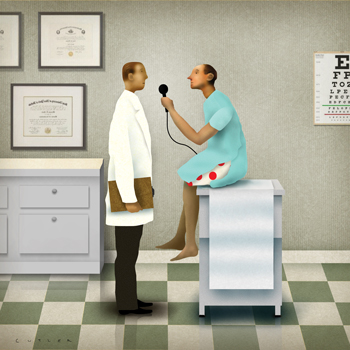Keep it simple for patient portal success
Experts recommend patient portals that implement a more stripped-down approach, with the focus falling on one or two straightforward components such as streamlining appointments and filling prescriptions.
Patient portals have become much more common, due in part to CMS's meaningful use requirements, but they may not always be designed with patients' needs and engagement in mind.
In a study published in December 2017 in the Journal of the American Medical Informatics Association, 63% of patients surveyed who received test results from outpatient clinicians through a portal received no accompanying explanation or interpretation. Nearly half the patients surveyed responded by seeking out their own information on the web.

“Many patients receive their test results in the portal in a format similar to the way the physicians see them,” said lead study author Traber Giardina, PhD, a patient safety researcher at the Michael E. DeBakey VA Medical Center and Baylor College of Medicine in Houston. “It's a really great tool, but it can be a challenge providing [information] in a way that's useful to patients so they're able to engage in their care. Most portals don't present data in a patient-centered way.”
Part of the issue, experts said, is that many practices installed portals without thinking carefully about how to use them or the goals they hoped to achieve. A portal boom occurred in and around 2014, when CMS required practices to have a portal to be eligible for funding through the “meaningful use” health IT incentive program, otherwise known as the Medicare EHR Incentive Program.
“Plenty of health care providers just wanted to check a box to say ‘Yes, we have it,’ for meaningful use,” said Ahmad Sharif, MD, chief medical information officer at Fresenius Medical Care, a Massachusetts-based health care company. “Our patients are chronically sick with multiple comorbidities and interact with us far more than average consumers interact with the health care system. It's very important for us that we engage our patients in a meaningful way. We aim to create value for the patients, not just check a box.”
Compounding the issue, different clinicians usually have different portals, each one with different functions and log-in credentials to memorize. Among patients with multiple doctors, patient portal fatigue, as it is known, is a very real risk.
Dr. Sharif noted that Fresenius Medical Care wants to significantly expand use of patient portals to engage and communicate with patients, most of whom have chronic renal conditions. Despite the company's efforts to develop useful portal tools, uptake has at times been underwhelming.
“Overall adoption of the portal wasn't as great as we would have liked, and we're not the only ones to have that problem,” he said. “In each health care venue, they give you another patient portal, so there may be patient portal fatigue.”
Keeping it simple
Studies have shown that patient portals have the potential to improve care and streamline staff workloads. A 2017 study in the online journal eGEMs found that patient portals were linked to improvements in patients' functional status and reductions in high-cost care. A 2015 analysis in the Journal of Medical Internet Research showed that portals can have a positive impact on patient satisfaction and retention. Mark McNeill, MD, a family physician in North Carolina, estimated in a 2016 case study published in FPM that his practice's portal “conservatively” resulted in 10,000 fewer phone calls to his office each year.
More robust functions can be valuable when a practice and its patients are particularly tech-savvy or have a specialized need. For the average practice, however, reducing a portal's functional footprint can raise its value and usage, physicians said.
Experts recommend considering a more stripped-down approach, with the focus falling on one or two straightforward components that can make a clear impact. Basic functions like streamlining appointments and filling prescriptions can provide quick wins for patient and clinician alike.
“The number-one benefit to an office practice for portals is if you can set it up to decrease the number of phone calls to the office,” said Patricia Hale, MD, FACP, Chair of ACP's Medical Informatics Committee. “The other is medication renewal and medication management … Patient satisfaction is much higher if you can do [prescription renewals] through the portals. If the patient goes through the portal, it's a big-time savings.”
Likewise, physicians and staff can simplify the patient experience. If test results reach the patient in their raw form, accompanying links to respected sources of online consumer health information can guide patients in interpretation—and head off the need for a follow-up phone call.
“Doctors can't necessarily write an explanation for every test result in the portal,” Dr. Giardina pointed out. “But we need to be sure the portal has information available to patients along with the test result. For instance, links with information on a given test should be available in the portal so that patients know it's from a trusted source.”
Fixing the system
The issue of portal fatigue may be difficult to address in the short term, experts said, but vendors are working to make systems more interoperable, allowing different systems and networks to more easily communicate with one another. Widespread interoperability may still be years away but might ultimately allow patients to access multiple portals with a single login and password, said Dugan Maddux, MD, FACP, vice president of kidney disease initiatives at Fresenius Medical Care.
“The technology will hopefully improve over time to change interoperability and help documents be easily shared across disparate systems,” she said.
In the meantime, if an update to an existing portal, or a new portal altogether, becomes important, Dr. Hale recommended physicians start by contacting their EHR vendors, being sure to ask questions about what they will get.
“There's a lot of inconsistency in what vendors offer, and it can cost money for every single upgrade,” she said. “With EHRs, maybe there are changing fees. … Some standalones say they will work with what you already have, but don't just take their word for it. Integration is a key benefit.”
Under current payment models, patient portal interactions are not reimbursable. However, the potential savings of a portal still can make the investment worthwhile, said Dr. Hale.
“Reimbursement is paid when people are in the office,” she said. “If the system moves to pay-for-performance, you won't have to pull the patient back in. Larger practices can perhaps negotiate with an insurer for bundling for certain chronic diseases, but for doctors in a one- to three-person practice, which is still the majority of practices in the country, that's not the case. Making an appointment and dealing with patients, helping with appointments, and medication management are the biggest benefits.”
Perhaps the most important predictor of patient portal success lies in the simplest form of doctor-patient communication. A brief conversation during the office visit about the portal can help demystify things for patients and encourage portal usage.
“A talk would involve priming patients, telling them what to expect, especially if the result is abnormal,” said Dr. Giardina. “Letting them know when to look out for their results, and if they have questions, get in contact.”
In an era where patient satisfaction is becoming increasingly important, making a quick connection about a tool that can improve the care experience for all parties involved may be the most effective way of securing buy-in.
“Portal adoption rates increase when the physician explains the value of portal, and that the patient can get a diagnosis explained, appointment scheduled or get a test result with pertinent explanation at their convenience,” said Dr. Sharif. “Just mention it for 30 seconds. Some people might be thinking about additional cost, but the majority of provider organizations I've spoken to have mentioned gaining more efficiencies, be it in operations, patient engagement, appointment scheduling, education or satisfaction surveys, and other things. It's a good win for practices.”




